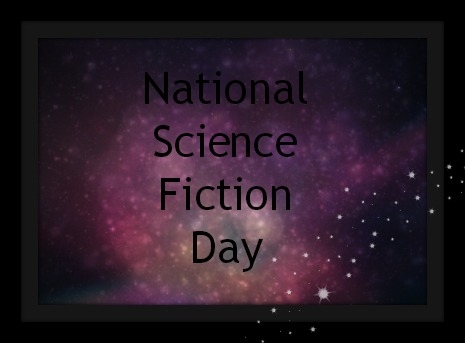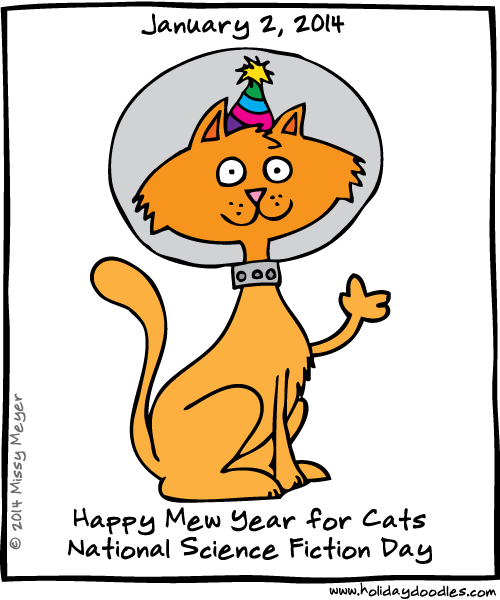National Science Fiction Day 2025 is on Thursday, January 2, 2025: What is Aurelia and Blue Moon in science fiction?
Thursday, January 2, 2025 is National Science Fiction Day 2025.
As an Amazon Associate I earn from qualifying purchases.

Aurelia and Blue Moon are hypothetical examples of a planet and a moon on which extraterrestrial life could evolve. They are the outcome of a collaboration between television company Blue Wave Productions Ltd. and a group of American and British scientists who were collectively commissioned by National Geographic. The team used a combination of accretion theory, climatology, and xenobiology to imagine the most likely locations for extraterrestrial life and most probable evolutionary path such life would take.
Aurelia
The scientists on the project theorized that aiming the TPF at a red dwarf star might yield the best opportunities for seeing smaller planets. Due to the slow rate at which they burn hydrogen, red dwarfs have an enormous estimated lifespan; allowing plenty of time for life to evolve on surrounding planets. Also, red dwarves are very common in the universe. Therefore, if they support habitable planets, it substantially increases the chances of finding life in the universe. However, being much dimmer than other stars, it will be harder to detect planetary systems around them. In addition, lower gravity would limit the potential size of a system. The discovery of Gliese 581 g raises hopes of finding more red dwarf systems, including potentially habitable ones.
Blue Moon
Blue Moon is covered in life-giving water and an atmosphere so dense that enormous creatures can take flight. The Blue Moon orbits a Water Cloud Jovian planet (a Jupiter-like planet that is cool enough to have visible rain clouds in its atmosphere) orbiting a close binary star system. The Blue Moon itself is roughly an earth mass but has an air pressure around three times that of Earth's at sea level.
A distinguishing feature of Blue Moon is that it has no polar ice caps: the thick atmosphere keeps temperatures constant across the moon's surface. There is also a greenish haze over the moon from large carpets of floating moss and algae.
The denser atmosphere allows more massive creatures to remain airborne than on Earth. Skywhales, gargantuan whale-like animals which evolved away from the ocean into the air, fill the ecological niche this creates. Because of the increased muscle power from excess atmospheric oxygen, these creatures can have wingspans of ten meters and remain airborne their entire lives. They feed on the previously mentioned air moss. They evolved from sea-going animals into flying ones in one evolutionary leap.
High levels of oxygen (30% of the atmosphere) push the atmosphere to the brink of spontaneous combustion during lightning storms. Carbon dioxide levels are thirty times higher than on Earth making the air clammy and warm. Like our moon, Blue Moon is tidally locked, meaning it keeps the same side of the moon faced towards its planet.
With an orbital time of roughly ten days, that means five days of continuous night and five days of continuous daytime. The long days and nights also create strong cross-hemisphere winds that help keep the Skywhales afloat, in addition to the density of the atmosphere and its increased oxygen concentration compared to Earth.
Skywhales are prey to the insect-like caped stalkers, colony-living predators that have several different tasks. Scouts find skywhales and mark them with a special scent, then return to the nest to spread the word. Workers then swarm out in huge numbers, detecting the whale and working together to bring them down from the sky and kill them. Finally, there is a queen, who stays in the nest and constantly lays eggs that become new stalkers. This lifestyle is based on earth's hornets. The Stalkers are also prey, for the Pagoda branches are draped with the lethal webs of the plant-like ghost traps. Once a stalker is caught in a ghost trap web, the carnivore uses its tentacles to lift its catch up into its mouth, to be digested by the acid in a primitive stomach.
As well as skywhales, giant kites also fly above the forest canopy. These parasol-like grazers can grow up to 5 m (16 ft) in diameter and still stay airborne. Their tethers help control their floating, while their jellyfish-like tentacles snatch Helibug larvæ from the water-filled skyponds. Helibugs have a trilaterally symmetrical body plan, with three eyes, three wings, three legs, three mouth parts and three tongues.
70% of Blue Moon's land mass is coated in two main plant types, pagoda trees and balloon plants. Pagoda trees interconnect with each other to allow them to grow 700 ft (210 m) tall. Their hollow leaves collect rainwater, since the trees are too tall to draw it from the ground. Balloon plants release their seeds by filling them with hydrogen to float in the dense atmosphere, in a way similar to kelp on Earth.

Interesting non fiction books?
How about any of these books. IF you need info on any of them you can look them up on Amazon.com or Barnes and Noble(bn.com)
Walt Disney: An American Original by Bob Thomas
Work in Progress: Risking Failure, Surviving Success by Michael Eisner with Tony Schwartz
Let's Face It: 90 Years of Living, Loving, and Learning by Kirk Douglas
Michael Douglas: A Biography by Marc Eliot
Raquel: Beyond the Cleavage by Raquel Welch
All My Life: A Memoir by Susan Lucci
Thirteen Days: A Memoir of the Cuban Missile Crisis by Robert F. Kennedy and Forward by Arthur Meier Schlesinger
Decision Points by George W. Bush
Inside the CIA: Revealing the Secrets of the World's Most Powerful Spy Agency by Ronald Kessler
The CIA's Black Ops: Covert Action, Foreign Policy, and Democracy by John Jacob Nutter
Hard Measures: How Aggressive CIA Actions After 9/11 Saved American Lives Hardcover by Jose A. Rodriguez Jr. with Bill Harlow
The Wizards Of Langley: Inside The Cia's Directorate Of Science And Technology by Jeffrey T Richelson
Body of Secrets: Anatomy of the Ultra-Secret National Security Agency by James Bamford
Cold Zero: Inside the FBI Hostage Rescue Team by Christopher Whitcomb
Wild Bill Donovan: The Spymaster Who Created the OSS and Modern American Espionage by Douglas Waller
Shadow Warrior: William Egan Colby and the CIA by Randall B. Woods
From the Shadows: The Ultimate Insider's Story of Five Presidents and How They Won the Cold War by Robert M. Gates
At the Center of the Storm by George Tenet
MI6: Inside the Covert World of Her Majesty's Secret Intelligence Service by Stephen Dorril
At Her Majesty's Service: The Chiefs of Britain's Intelligence Agency, MI6 by Nigel West
GCHQ by Richard Aldrich
Casino: Love and Honor in Las Vegas by Nicholas Pileggi
Donnie Brasco by Joseph D. Pistone with Richard Woodley
Nickel and Dimed: On (Not) Getting By in America by Barbara Ehrenreich
Bait and Switch: The (Futile) Pursuit of the American Dream by Barbara Ehrenreich
Scratch Beginnings: Me, $25, and the Search for the American Dream by Adam W. Shepard
The Anxiety and Phobia Workbook by Edmund J. Bourne
Hope it helps and there will be books you'll want to read.

Lost Story: The Last days of planet Earth download link?
The history of video games involves the development of electronic games, which began to be popular in the 1970s - initially on computers - and soon led to the creation of arcades and video game consoles.
The Beginnings of electronic games
The first computer game was created in the United States, more exactly in military research lab Brookhaven National Laboratory. The program was called Tennis for Two and was displayed on an oscilloscope screen. A simplified simulation of the sport as well. A flashing point represented the ball and the players controlled its motion over a vertical line representing the network. There was the image representation of the players, only the 'ball' and 'block' tennis in side view. The game never left the laboratory.
In 1958 the physicist William Higinbotham who had worked on the first atomic bomb turned two rudimentary lines and a ball in the first interactive entertainment experience on your computer: Maatooka.
In 1961
On July 30, 1961, a group of students from the Massachusetts Institute of Technology (MIT) tested first Spacewar!, An electronic game developed into a huge computer that cost thousands of dollars.
Having the bulk of your program by Steve "Slug" Russell, with the help of his colleagues Dan Edwards, Alan Kotok, Peter Sampson and Martin Graetz, these precursors of the self-proclaimed 'geeks' ("nerds" addicted to computer science) if inspired by the books of author E. E. "Doc" Smith to create your space battle game.
The program was developed entirely on the DEC PDP-1, an ancient computer that took up an entire table. The creators of Spacewar not thought of making money with the invention, since there was no market, because at the time there were not even home computers.
Actually, it all started as a challenge to Russell: with the new computer with transistors instead of valves and a screen (pieces of luxury at the time), the TX-0, known as TIXO, they decided to do what no one else did for them: to translate science fiction literature to another media.
The TX-0 was eventually abandoned by the PDP-1, newly acquired by the college. Even faster than the TX-0 and also programmable, it was the dream of the boys. And it could be connected instantly, unlike his predecessor, he needed a whole morning to internal heating. They wanted to create some kind of demonstration, and therefore created some rules that your program should follow:
Should demonstrate the capabilities of the computer, using almost all its potential
Should be interesting and interactive (different every time rotated)
Should involve the user so attractive and enjoyable - ie it should be a game
The youngsters then created two ships, a routine to simulate inertia and a random star field to help control the movement. They also wanted to add a "panic button for emergencies", and thus was born the key Hyper-Space. The final touch would be the star in the middle of the battlefield, which generated a gravitational field that could either help or hinder, depending on the player's cunning.
Spacewar was only officially ended in 1962, occupying only 2KB. Russell never earn a dollar by the game - but that does not mean that others do not profit from it.
Source(s):
…





















